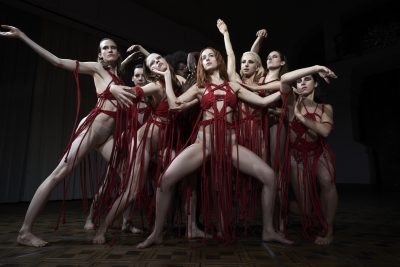
Suspiria – Sara (Mia Goth) and Susie (Dakota Johnson) – Photo courtesy of
Luca Guadagnino’s Suspiria is an hour longer than the original – and half as substantive.
There are certain things that are batsh*t crazy – covering Frank Zappa and The Mothers of Invention; diving into a frozen river, and remaking/reimaging Dario Argento’s classic giallo, Suspiria (even with Argento’s blessing).
The original synopsis of the film reads, ‘Young American dancer Susie Bannion (Dakota Johnson) arrives in 1970s Berlin to audition for the world-renowned Helena Markos Dance Company, stunning the troupe’s famed choreographer, Madame Blanc (Tilda Swinton), with her raw talent.
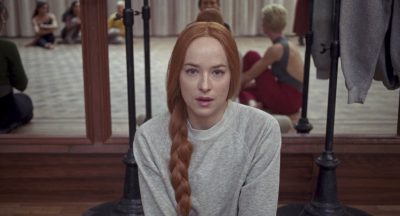
Suspiria – Susie Bannion (Dakota Johnson) – Photo courtesy of Amazon Studios.
When she vaults to the role of lead dancer, Olga, the previous lead, breaks down and accuses the company’s female directors of being witches. As rehearsals intensify for the final performance of the company’s signature piece, Susie and Madame Blanc grow strangely close, suggesting that Susie’s purpose in the company goes beyond merely dancing.
Meanwhile, an inquisitive psychotherapist trying to uncover the company’s dark secrets enlists the help of another dancer, who probes the depths of the studio’s hidden underground chambers, where horrific discoveries await.’
While being pretty straightforward, the synopsis merely hints at Suspiria’s horrors (not to mention its boring bits).
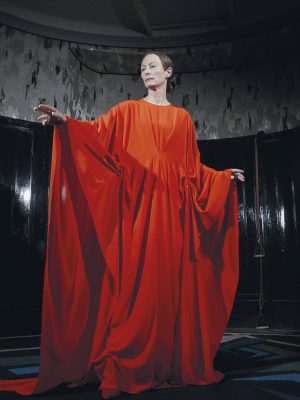
Suspiria – Madame Blanc (Tilda Swinton) – Photo courtesy of Amazon Studios.
It takes more than half-an-hour before we begin to see the supernatural aspects of Suspiria – when Susie dances and it has a rather stunning side effect (a body horror sequence that would warm David Cronenberg’s heart).
Up until then, we’ve been meeting the characters and learning their situations – beginning with Patricia Hingle (Chloë Grace Moretz).
The film opens with Patricia running from something and seeking refuge with her psychotherapist, Dr. Josef Klemperer (Lutz Ebersdorf – a Swinton pseudonym) – where she babbles on and on about them being out to get her. They’ve taken her hair, urine and eyes…
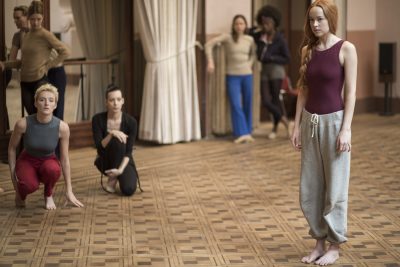
Suspiria – Susie (Dakota Johnson) – Photo by Sandro Kopp/Courtesy of Amazon Studios.
Klemperer is, of course, of the opinion that she’s delusion.
Things work out that as Patricia is vanishing/vanished, Young America Susie arrives – her audition impressing the great Madame Blanc, who has stepped in to see her audition.
Before long, Susie is dancing lead in a difficult piece and the supernatural grabs hold of the film with that supernatural body horror sequence I mentioned above.
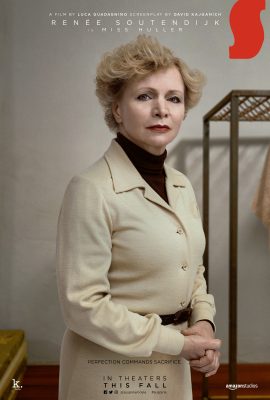
In between the three or four major horror sequences, though, there are long stretches that are meant to be ambiguous – are they dreams/nightmares or real events?
These ambiguous segments are interspersed with segments that are meant to be real – but after an hour-and-a-half, it’s awfully hard to tell which is which.
Written by David Kajganich (The Terror) and directed by Guadagnino, Suspiria mixes an opening dash of psychological drama and very slowly goes full bore wakka-wakka-cuckoo-garbonzo-beans nuts.
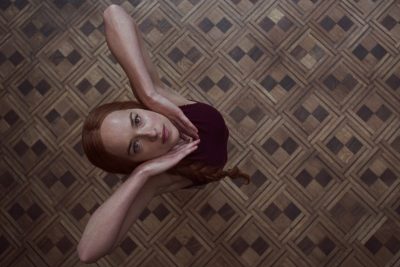
The climactic orgy sequence is easily the least sexy orgy I’ve ever seen (the one on Westworld in season one was much better that way).
Guadagnino may have been using Suspiria to strike a blow for women’s power – the alleged victim, the new girl and the teachers at the school are all powerful in their own ways.
A brief Sequence with two police Dr. Klemperer asked to investigate the missing Patricia further builds us awareness of their power.
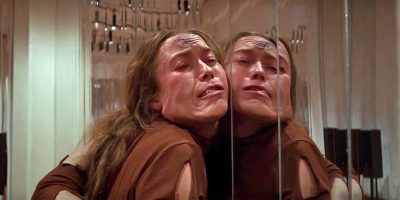
Suspiria – Olga (Elena Fokina) – Photo courtesy of Amazon Studios.
Outside of the few of the body horror sequences, though, Guadagnino’s Suspiria is just too long to really work – not when it’s long action-free stretches don’t really add to a deeper understanding of our characters.
Put this one on the rental or pay cable queue.
Final Grade: C